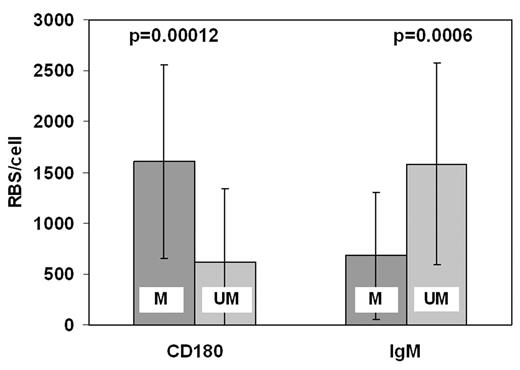Abstract
Introduction. B cell chronic lymphocytic leukaemia (B-CLL) is a heterogeneous disease as shown by differential expression of a variety of surface and cytoplasmic markers. In a search for markers that could define biological activity of different B-CLL subsets, we have studied the surface expression of the Toll-like receptor (TLR) family member CD180 in relation to other surface markers and mutation status of IgVh genes.
Methods. Seventy eight B-CLL patients (68 untreated and 10 treated) and 15 age-matched controls were studied in three different clinics. CD19+ B cells were stained using indirect immuno fluorescence for CD180, surface IgM (sIgM), CD79b and CD38, analysed by flow cytometry and data expressed as the relative antibody binding sites (RBS)/cell for each marker. Monoclonal anti-CD5 antibodies were also used with anti CD180 to determine levels of expression of CD180 in control CD5+ cells. IgVh mutation was determined for 47 patients.
Results B-CLL cells had variable levels of CD180 expression, but this was always less (1036 ± 935 RBS/cell) than that expressed by normal blood B cells (5548 ± 2271 RBS/cell) and was stable for up to 18 months. Significantly higher levels of CD180 were expressed by B-CLL cells with mutated (M) compared with those using unmutated (UM) IgVh genes. This was in contrast to the higher levels of expression of sIgM by B-CLL cells using UM than M IgVh genes (Figure).
Conclusions. CD180 is expressed at higher levels on B-CLL cells using M than those using UM IgVh genes and is in contrast to the level of expression of sIgM which is higher on B-CLL cells using UM versus M genes.
This differential expression of CD180 supports the notion that B-CLL cells using UM IgVh genes represent a population of cells actively responding to signals (perhaps to self antigens) via their surface IgM.
Author notes
Corresponding author


This feature is available to Subscribers Only
Sign In or Create an Account Close Modal